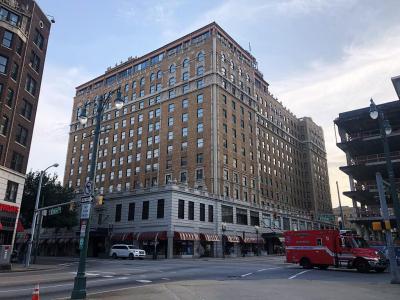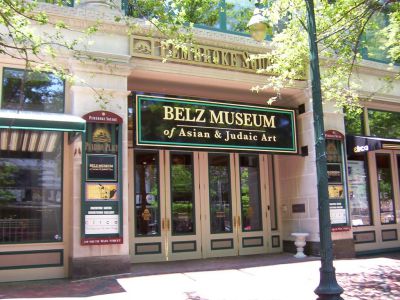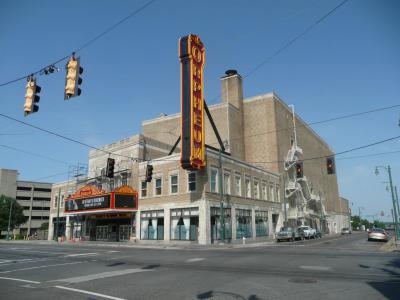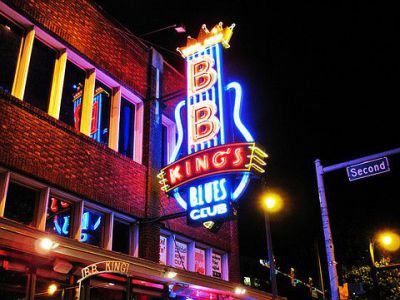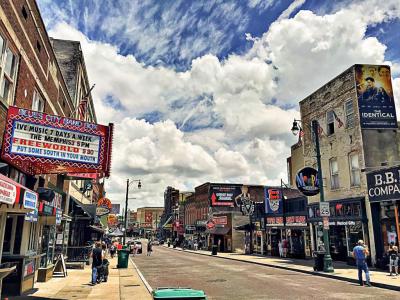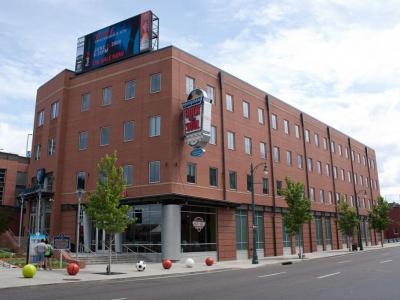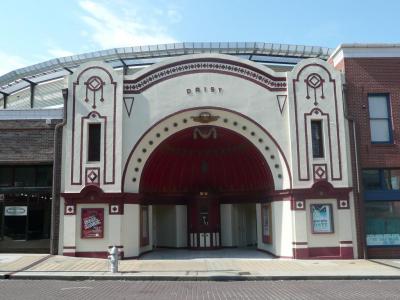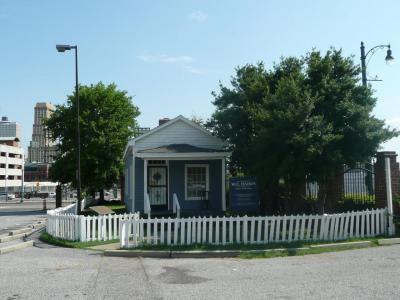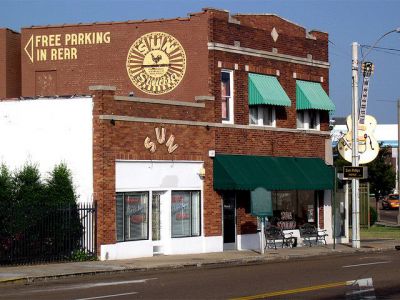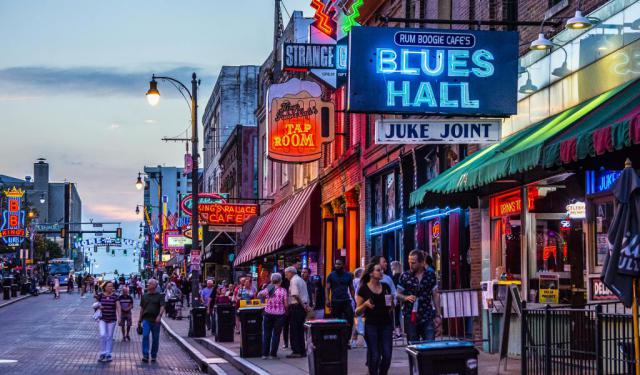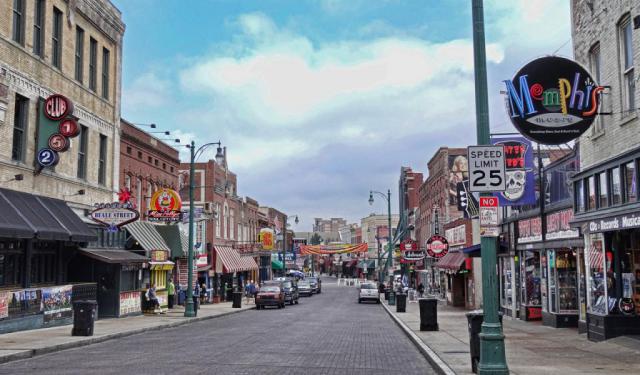
Memphis Introduction Walking Tour (Self Guided), Memphis
One of the most iconic destinations in the United States, the city of Memphis has gone down in history for many different reasons. Set on a bluff over the Mississippi River, the site of today's Memphis has been settled for over a thousand years by various cultures, including the Indian tribe of Chickasaw. The latter encountered European explorers in the 16th century. In the 18th century, Spain and the United States vied for control of this territory.
The city of Memphis was founded on May 22, 1819 and was named after the ancient capital of Egypt on the Nile River. In the 19th century, the city developed as a trade and transportation center because of its flood-free location, with the outlying areas developed as cotton plantations, making it a major cotton market and brokerage center. Eventually, Memphis grew to become a major market for the domestic slave trade, as the cotton economy of the antebellum South depended heavily on the forced labor of African-American slaves.
During the 1960s, the city played a prominent role in the American Civil Rights Movement, as its large African-American population had been affected by state segregation practices in the early 20th century. Consequently, Memphis was the site of Dr. Martin Luther King, Jr.'s assassination in 1968.
Today, Memphis is a regional center for commerce, education, media, art, and entertainment. Known for its cultural contributions to the identity of the American South, it has long had a prominent music scene shaped by a multi-cultural mix of influences across the blues, jazz, country, rock n' roll, soul, and hip-hop genres. Many renowned musicians grew up in and around the city, such as Elvis Presley, Jerry Lee Lewis, Muddy Waters, Johnny Cash, W. C. Handy, B.B. King, Howlin' Wolf, Justin Timberlake, and Aretha Franklin, to mention but a few.
Thousands of tourists flock to Memphis each year out of desire to visit the legendary Sun Studio where Elvis made his early recordings or the local Rock 'n' Soul Museum, or to take a stroll down Beale Street with its historic blues clubs and restaurants dishing up Memphis-style barbecue and soul food, or to check out the elegant Peabody Hotel’s famed ducks marching down a red carpet each morning to the lobby fountain. To find your way around these and other major attractions in Memphis, follow this self-guided introduction walk!
The city of Memphis was founded on May 22, 1819 and was named after the ancient capital of Egypt on the Nile River. In the 19th century, the city developed as a trade and transportation center because of its flood-free location, with the outlying areas developed as cotton plantations, making it a major cotton market and brokerage center. Eventually, Memphis grew to become a major market for the domestic slave trade, as the cotton economy of the antebellum South depended heavily on the forced labor of African-American slaves.
During the 1960s, the city played a prominent role in the American Civil Rights Movement, as its large African-American population had been affected by state segregation practices in the early 20th century. Consequently, Memphis was the site of Dr. Martin Luther King, Jr.'s assassination in 1968.
Today, Memphis is a regional center for commerce, education, media, art, and entertainment. Known for its cultural contributions to the identity of the American South, it has long had a prominent music scene shaped by a multi-cultural mix of influences across the blues, jazz, country, rock n' roll, soul, and hip-hop genres. Many renowned musicians grew up in and around the city, such as Elvis Presley, Jerry Lee Lewis, Muddy Waters, Johnny Cash, W. C. Handy, B.B. King, Howlin' Wolf, Justin Timberlake, and Aretha Franklin, to mention but a few.
Thousands of tourists flock to Memphis each year out of desire to visit the legendary Sun Studio where Elvis made his early recordings or the local Rock 'n' Soul Museum, or to take a stroll down Beale Street with its historic blues clubs and restaurants dishing up Memphis-style barbecue and soul food, or to check out the elegant Peabody Hotel’s famed ducks marching down a red carpet each morning to the lobby fountain. To find your way around these and other major attractions in Memphis, follow this self-guided introduction walk!
How it works: Download the app "GPSmyCity: Walks in 1K+ Cities" from Apple App Store or Google Play Store to your mobile phone or tablet. The app turns your mobile device into a personal tour guide and its built-in GPS navigation functions guide you from one tour stop to next. The app works offline, so no data plan is needed when traveling abroad.
Memphis Introduction Walking Tour Map
Guide Name: Memphis Introduction Walking Tour
Guide Location: USA » Memphis (See other walking tours in Memphis)
Guide Type: Self-guided Walking Tour (Sightseeing)
# of Attractions: 9
Tour Duration: 2 Hour(s)
Travel Distance: 2.4 Km or 1.5 Miles
Author: val
Sight(s) Featured in This Guide:
Guide Location: USA » Memphis (See other walking tours in Memphis)
Guide Type: Self-guided Walking Tour (Sightseeing)
# of Attractions: 9
Tour Duration: 2 Hour(s)
Travel Distance: 2.4 Km or 1.5 Miles
Author: val
Sight(s) Featured in This Guide:
- Peabody Hotel
- Belz Museum of Asian and Judaic Art
- Orpheum Theatre
- B.B. King's Blues Club
- Beale Street
- Memphis Rock 'n' Soul Museum
- Old Daisy Theatre
- W.C. Handy House Museum
- Sun Studio
1) Peabody Hotel (must see)
The Peabody Hotel is a four star hotel best known for its most famous residents, the Peabody Ducks. Each day at 11 am, the ducks march into the hotel lobby for a swim in the fountain. They are accompanied by the duck master and the King Cotton March by John Phillip Sousa. The ducks are a popular attraction and hundreds of people line up to see them every day. In addition, many celebrities have acted as an honorary duck master throughout the years.
The duck tradition began in 1932 when the general manager and his friend placed live decoy ducks in the hotel lobby fountain as a joke. The public liked it and the tradition continued with five mallard ducks, one male and four female. The ducks work an average of three months before they are retired.
The original Peabody Hotel was built by Robert Campbell Brinkley in 1869 and was located on the corner of Main and Monroe Streets. Its most famous resident was Jefferson Davis, the former President of the Confederacy.
The current hotel was designed by Walter W. Ahlschlager and opened in 1925. In 1965, the hotel went bankrupt and was sold to the Sheraton Hotels, renamed the Sheraton–Peabody Hotel. After the Sheraton closed in 1973, Isadore Edwin Hanover bought the hotel and sold it to his son-in-law, Jack A. Belz. After years of restoration work, the building reopened in 1981.
The Peabody Skyway, a top floor that contains a lounge, bar, and ballroom, was a popular hangout during the 1940s. The hotel Plantation Roof offers great views of the Memphis skyline and is the site of the famous Thursday night "Rooftop Parties.”
Bernard Lansky's store, located in the hotel's lobby, is legendary. Elvis used to called him "Mr. Lansky," while faithful customers call him "Mr. B.", and the world knows him as "Clothier to the Stars". Elvis collaborated with Mr Lansky throughout the course of his career. When he first bought a shirt from Lansky it the 1950s, it cost just $3.95. As Elvis became more famous, Lansky was named his PR man all over the world. Frank Sinatra, Carl Perkins, and B.B. King have also shopped at Lansky at the Peabody.
***Elvis Presley Walk***
This hotel is where Elvis went for his senior prom. He is rumored to have told his date that he didn’t dance and was incredibly nervous the whole night – a hard to believe line from a man who swayed his hips and made the girls swoon.
In the Hotel's Memorabilia Room one can still see the contract signed by Elvis Presley in the hotel lobby when he left the Sun Records for RCA.
The duck tradition began in 1932 when the general manager and his friend placed live decoy ducks in the hotel lobby fountain as a joke. The public liked it and the tradition continued with five mallard ducks, one male and four female. The ducks work an average of three months before they are retired.
The original Peabody Hotel was built by Robert Campbell Brinkley in 1869 and was located on the corner of Main and Monroe Streets. Its most famous resident was Jefferson Davis, the former President of the Confederacy.
The current hotel was designed by Walter W. Ahlschlager and opened in 1925. In 1965, the hotel went bankrupt and was sold to the Sheraton Hotels, renamed the Sheraton–Peabody Hotel. After the Sheraton closed in 1973, Isadore Edwin Hanover bought the hotel and sold it to his son-in-law, Jack A. Belz. After years of restoration work, the building reopened in 1981.
The Peabody Skyway, a top floor that contains a lounge, bar, and ballroom, was a popular hangout during the 1940s. The hotel Plantation Roof offers great views of the Memphis skyline and is the site of the famous Thursday night "Rooftop Parties.”
Bernard Lansky's store, located in the hotel's lobby, is legendary. Elvis used to called him "Mr. Lansky," while faithful customers call him "Mr. B.", and the world knows him as "Clothier to the Stars". Elvis collaborated with Mr Lansky throughout the course of his career. When he first bought a shirt from Lansky it the 1950s, it cost just $3.95. As Elvis became more famous, Lansky was named his PR man all over the world. Frank Sinatra, Carl Perkins, and B.B. King have also shopped at Lansky at the Peabody.
***Elvis Presley Walk***
This hotel is where Elvis went for his senior prom. He is rumored to have told his date that he didn’t dance and was incredibly nervous the whole night – a hard to believe line from a man who swayed his hips and made the girls swoon.
In the Hotel's Memorabilia Room one can still see the contract signed by Elvis Presley in the hotel lobby when he left the Sun Records for RCA.
2) Belz Museum of Asian and Judaic Art (must see)
Located on South Main Street, the Belz Museum of Asian and Judaic Art contains the largest collection of Chinese art (tapestries, furniture, carvings, and other artifacts from the Qing period) in the southern United States and an impressive collection of items related to Judaism, totaling over 1,000. The exhibition hall was established in 1998.
Most of the artifacts come from the private collection of Jack and Marilyn Betz. Among these are the works by Ofra Friedland, Daniel Kafr, Marc Chagall, Mane Katz. Of special interest are the 32 bronze sculptures created by Daniel Kafri.
Tours are available Tuesday through Friday from 10 am to 4 pm. Docent tours are also available to the public upon request. In addition, there are tours specifically targeted towards educating students. Photography and movie and video cameras are not allowed in the galleries. The museum’s Dynasty room is available for rental for groups of 25 or more who wish to experience a Chinese feast with tea. The museum shop sells cards, gifts, and other accessories reflecting a Judaic or Asian theme.
Most of the artifacts come from the private collection of Jack and Marilyn Betz. Among these are the works by Ofra Friedland, Daniel Kafr, Marc Chagall, Mane Katz. Of special interest are the 32 bronze sculptures created by Daniel Kafri.
Tours are available Tuesday through Friday from 10 am to 4 pm. Docent tours are also available to the public upon request. In addition, there are tours specifically targeted towards educating students. Photography and movie and video cameras are not allowed in the galleries. The museum’s Dynasty room is available for rental for groups of 25 or more who wish to experience a Chinese feast with tea. The museum shop sells cards, gifts, and other accessories reflecting a Judaic or Asian theme.
3) Orpheum Theatre (must see)
Located on South Main Street, the Orpheum Theatre is one of the last movie palaces from the 1920s still in existence. Originally built in 1890, it was known as the Grand Opera House. Today it is a home to the Ballet Memphis and Opera Memphis troupes.
Broadway, film, and concerts are staged here on a regular basis. Cats, Mamma Mia, and Joseph and the Amazing Technicolor Dreamcoat are just a few of the shows that have graced the Orpheum’s stage over the years.
The theater has staying power. It survived a 1923 fire, bankruptcy, demolition, and the decline of the city. Through all of its trials, the Orpheum has rebounded and today remains one of the “South’s Finest Theatres.” In 1976, it underwent a $5 million renovation that restored the theater to its former 1928 glory.
It is rumored that the building is haunted by two ghosts. One of the ghosts is a nine year old girl named Mary and the other is a masked figure who lives in the air ducts above the house. Mary likes to slam doors and make lights flicker. The ghost with no name likes to wave at audience members.
The theater is available for rental and offers many programs to educate the public about the arts. In addition, tours are available for groups at different times throughout the year.
Broadway, film, and concerts are staged here on a regular basis. Cats, Mamma Mia, and Joseph and the Amazing Technicolor Dreamcoat are just a few of the shows that have graced the Orpheum’s stage over the years.
The theater has staying power. It survived a 1923 fire, bankruptcy, demolition, and the decline of the city. Through all of its trials, the Orpheum has rebounded and today remains one of the “South’s Finest Theatres.” In 1976, it underwent a $5 million renovation that restored the theater to its former 1928 glory.
It is rumored that the building is haunted by two ghosts. One of the ghosts is a nine year old girl named Mary and the other is a masked figure who lives in the air ducts above the house. Mary likes to slam doors and make lights flicker. The ghost with no name likes to wave at audience members.
The theater is available for rental and offers many programs to educate the public about the arts. In addition, tours are available for groups at different times throughout the year.
4) B.B. King's Blues Club
If you fancy Southern food classics with some great live Memphis Blues in a brightly decorated listening room, then head to B.B. King’s! This iconic blues club opened in Memphis in 1991 and has remained a favorite of locals and visitors alike ever since. Widely regarded as the best restaurant, bar, and live music joint on Beale Street, B.B. King's is more than the just Blues but is also about classic Soul and Rock and Roll, much as it is about great barbecue (let alone the local specialties, such as Southern Fried Catfish or Broiled Steak) and signature drinks fit to fill anyone up to the brim!
You just have to experience it first-hand because words can’t fully describe the vibe of this place. With two levels of dining and a dance floor, and the daily live music show, featuring the in-house B.B. King All-Star Band, you should really prepare yourself for the late-night partying and, possibly, even dancing till the early hours in the morning! Just don’t forget your blue suede shoes!
You just have to experience it first-hand because words can’t fully describe the vibe of this place. With two levels of dining and a dance floor, and the daily live music show, featuring the in-house B.B. King All-Star Band, you should really prepare yourself for the late-night partying and, possibly, even dancing till the early hours in the morning! Just don’t forget your blue suede shoes!
5) Beale Street (must see)
Beale Street, often referred to as the "Home of the Blues," holds a prominent place in Memphis as one of America's most renowned streets, particularly in the realm of entertainment. In 1909, a notable event took place on this very street when W. C. Handy composed a campaign song called "Mr. Crump" for E. H. Crump, a prominent figure in the political machine. This song was later renamed "The Memphis Blues." Additionally, in 1916, Handy penned another influential piece entitled "Beale Street Blues," which played a pivotal role in the decision to change the street's name from Beale Avenue to Beale Street.
From the 1920s to the 1940s, Beale Street witnessed the performances of legendary musicians such as Louis Armstrong, Muddy Waters, Albert King, Memphis Minnie, B. B. King, Rufus Thomas, Rosco Gordon, and others. Their contributions significantly shaped the musical style known as Memphis Blues. Notably, B. B. King was introduced as "the Beale Street Blues Boy" during his early career.
Beale Street holds great historical significance for the city and the blues music genre. In recognition of its importance, the stretch of the street spanning from Main to 4th Street was designated as a National Historic Landmark on May 23, 1966. In the present day, the blues clubs and restaurants along Beale Street are major attractions for tourists visiting Memphis. The street frequently hosts festivals and outdoor concerts, drawing substantial crowds to the area. Moreover, more than 25 clubs and shops selling Memphis-themed souvenirs can be found in this vibrant locale.
Why You Should Visit:
To enjoy authentic Memphis soul food, listen to live music, or party!
***Elvis Presley Walk***
The young Elvis used to spend a lot of time with the musicians gathered on Beale street. The music and the vibe of the street had a great influence on him. Today, his name can be spotted on one of the brass notes on the Beale Street Brass Notes Walk of Fame.
From the 1920s to the 1940s, Beale Street witnessed the performances of legendary musicians such as Louis Armstrong, Muddy Waters, Albert King, Memphis Minnie, B. B. King, Rufus Thomas, Rosco Gordon, and others. Their contributions significantly shaped the musical style known as Memphis Blues. Notably, B. B. King was introduced as "the Beale Street Blues Boy" during his early career.
Beale Street holds great historical significance for the city and the blues music genre. In recognition of its importance, the stretch of the street spanning from Main to 4th Street was designated as a National Historic Landmark on May 23, 1966. In the present day, the blues clubs and restaurants along Beale Street are major attractions for tourists visiting Memphis. The street frequently hosts festivals and outdoor concerts, drawing substantial crowds to the area. Moreover, more than 25 clubs and shops selling Memphis-themed souvenirs can be found in this vibrant locale.
Why You Should Visit:
To enjoy authentic Memphis soul food, listen to live music, or party!
***Elvis Presley Walk***
The young Elvis used to spend a lot of time with the musicians gathered on Beale street. The music and the vibe of the street had a great influence on him. Today, his name can be spotted on one of the brass notes on the Beale Street Brass Notes Walk of Fame.
6) Memphis Rock 'n' Soul Museum (must see)
Located on the famous Beale Street, the Memphis Rock ‘n’ Soul Museum tells the story of Memphis music from its early beginnings to the present. Educating the masses about the music is the central theme of the museum and the seven galleries herein showcase a wide variety of genres, from the music sung in the fields to gospel, blues, country, rhythm and blues, and rock ‘n’ roll.
The museum was created by the Smithsonian Institution in 2000 as a research project. Visitors will enjoy the videos, recordings, photographs of artists such as, Otis Redding, Al Green, and Earth, Wind, and Fire.
Three recommended tour stops are the Bravo Gallery that honors artists who made an impact on the world music, the Soul Music exhibit that features the works of legendary record labels such as STAX, HI Records and Sun Records, and the Youth Culture exhibit that features artifacts from the record company that helped Elvis Presley and Jerry Lee Lewis get their start.
The on-site Levy Restaurants offers catering services for a variety of functions at the exhibition hall.
The museum was created by the Smithsonian Institution in 2000 as a research project. Visitors will enjoy the videos, recordings, photographs of artists such as, Otis Redding, Al Green, and Earth, Wind, and Fire.
Three recommended tour stops are the Bravo Gallery that honors artists who made an impact on the world music, the Soul Music exhibit that features the works of legendary record labels such as STAX, HI Records and Sun Records, and the Youth Culture exhibit that features artifacts from the record company that helped Elvis Presley and Jerry Lee Lewis get their start.
The on-site Levy Restaurants offers catering services for a variety of functions at the exhibition hall.
7) Old Daisy Theatre
Located on the famous Beale Street, the Old Daisy Theater is known as the “#1 tourist attraction in the State of Tennessee". Built in 1902, the venue was a major stop on the “Chitlin’ Circuit” from the 1930s to the 1960s. The “Chitlin’ Circuit” was the only safe way for Rhythm and Blues artists to perform in the segregated South. George Benson, Ike and Tina Turner, Duke Ellington, the Jackson Five, Lena Horne, the Temptations, Aretha Franklin, and Wilson Pickett are just a few of the many musical artists who toured the South in this manner.
The theater reflects a Nickelodeon-Style design and features a horse-shaped balcony that is supported with iron rods, and a stage and screen located on the sidewalk. In the 1980s, the building was converted into a Blues Museum.
A new Daisy Theater was built across the street in the 1930s featuring live entertainment from established and up-and-coming artists, such as John Lee Hooker, Al Green, Sam and Dave, Bob Dylan, Alice in Chains, Justin Timberlake, Nelly, and the Cult.
Currently, the Old Daisy Theater serves as a banquet hall for meetings, events, and banquets. Catering services are available.
The theater reflects a Nickelodeon-Style design and features a horse-shaped balcony that is supported with iron rods, and a stage and screen located on the sidewalk. In the 1980s, the building was converted into a Blues Museum.
A new Daisy Theater was built across the street in the 1930s featuring live entertainment from established and up-and-coming artists, such as John Lee Hooker, Al Green, Sam and Dave, Bob Dylan, Alice in Chains, Justin Timberlake, Nelly, and the Cult.
Currently, the Old Daisy Theater serves as a banquet hall for meetings, events, and banquets. Catering services are available.
8) W.C. Handy House Museum
This modest Beale Street house was once the address of William Christopher Handy (1873–1958) who went down in history as the "Father of the Blues". Handy moved to Memphis, Tennessee in 1909 from his native Alabama after touring through Mississippi. He settled in a two-room shotgun house on Jeanette Place in South Memphis. Here the legendary classics like "The Memphis Blues," "Saint Louis Blues," and "Beale Street Blues" were written, the tunes of which still seem to be floating in the air!
In the mid-1980s, the home was moved to Beale Street and restored; it currently serves as an interpretive center. Although the house displays just a sampling of Handy memorabilia and artifacts, numerous old photos will lead you through the highlights of W.C. Handy's fascinating life. There's even the desk at which he wrote many of his famous songs.
Whilst perusing old photos, you'll be able to listen to the commentary from a knowledgeable guide. The W.C. Handy house is a quick stop, since the museum is small and the tour only lasts about 20 minutes.
In the mid-1980s, the home was moved to Beale Street and restored; it currently serves as an interpretive center. Although the house displays just a sampling of Handy memorabilia and artifacts, numerous old photos will lead you through the highlights of W.C. Handy's fascinating life. There's even the desk at which he wrote many of his famous songs.
Whilst perusing old photos, you'll be able to listen to the commentary from a knowledgeable guide. The W.C. Handy house is a quick stop, since the museum is small and the tour only lasts about 20 minutes.
9) Sun Studio (must see)
No trip to Memphis would be complete without a stop at the famous Sun Studio. Originally, it was called the Memphis Recording Service. The studio was opened by Sam Phillips in 1950 and was located in the same building as the Sun Records record label. Elvis Presley, Roy Orbison, Johnny Cash, Ike Turner, and B.B. King are just a few of the greats who either recorded here or were signed at the label.
The studio was nicknamed the “Birthplace of Rock ‘n’ Roll” when Ike and Tina Turner recorded here their Rocket 88 song, considered by many to be the first Rock ‘n’ Roll track. In 1960, the studio was moved to Madison Avenue and renamed Phillips Recording.
Twenty-five years later, Phillips returned to the Sun with Carl Perkins, Roy Orbison, Johnny Cash and Jerry Lee Lewis to record the Class of '55 album. In 1987, the studio was restored to its former glory and became a tourist attraction while still remaining a fully-operational recording facility.
During the day, the building is open for tours. In the evening, artists can rent the studio to make records. Among the "must-see's" here are the video interviews with people who either recorded themselves or worked with those who had recorded at the studio.
The studio was nicknamed the “Birthplace of Rock ‘n’ Roll” when Ike and Tina Turner recorded here their Rocket 88 song, considered by many to be the first Rock ‘n’ Roll track. In 1960, the studio was moved to Madison Avenue and renamed Phillips Recording.
Twenty-five years later, Phillips returned to the Sun with Carl Perkins, Roy Orbison, Johnny Cash and Jerry Lee Lewis to record the Class of '55 album. In 1987, the studio was restored to its former glory and became a tourist attraction while still remaining a fully-operational recording facility.
During the day, the building is open for tours. In the evening, artists can rent the studio to make records. Among the "must-see's" here are the video interviews with people who either recorded themselves or worked with those who had recorded at the studio.
Walking Tours in Memphis, Tennessee
Create Your Own Walk in Memphis
Creating your own self-guided walk in Memphis is easy and fun. Choose the city attractions that you want to see and a walk route map will be created just for you. You can even set your hotel as the start point of the walk.
Memphis Blues Walking Tour
If you're a music fan, visiting Memphis, Tennessee, is a must! As the cradle of blues, this city has influenced many musicians and music lovers worldwide. The soulful blues genre is deeply rooted in the history of Memphis. Below is just a sample of an awesome list of places to learn more about Memphis Blues’ juicy past, present, and future.
One of the essential stops for any blues... view more
Tour Duration: 2 Hour(s)
Travel Distance: 1.8 Km or 1.1 Miles
One of the essential stops for any blues... view more
Tour Duration: 2 Hour(s)
Travel Distance: 1.8 Km or 1.1 Miles
Historical Buildings Walking Tour
A substantial part of Memphis' heritage is manifested in its iconic buildings. By far more than just bricks and mortar, they are a history window through which one can observe the city's growth and development over the years. Here's a brief overview of some of these notable structures.
Harsson-Goyer-Lee House: This charming 19th-century mansion stands as a testament to... view more
Tour Duration: 2 Hour(s)
Travel Distance: 3.1 Km or 1.9 Miles
Harsson-Goyer-Lee House: This charming 19th-century mansion stands as a testament to... view more
Tour Duration: 2 Hour(s)
Travel Distance: 3.1 Km or 1.9 Miles
Memphis Downtown Walking Tour
Downtown is the oldest part of Memphis. This vibrant and culturally rich district is home to a variety of historical, artistic, and entertainment destinations that collectively reflect the unique heritage and spirit of the “blues city”.
One of the area's standout attractions is the Fire House Museum, a fascinating spot where visitors can explore the history of the city's fire... view more
Tour Duration: 2 Hour(s)
Travel Distance: 3.1 Km or 1.9 Miles
One of the area's standout attractions is the Fire House Museum, a fascinating spot where visitors can explore the history of the city's fire... view more
Tour Duration: 2 Hour(s)
Travel Distance: 3.1 Km or 1.9 Miles
Elvis Presley Walking Tour
Above all other celebrities, Memphis, Tennessee, is primarily associated with Elvis Aaron Presley (known to the majority worldwide simply as Elvis). Thus, it is not at all surprising that Memphis serves as a sort of shrine to the man and his music. Even though Presley passed away in 1977, his fans keep flocking into the city to this day to pay their respects to the King of Rock 'n' Roll.... view more
Tour Duration: 2 Hour(s)
Travel Distance: 3.5 Km or 2.2 Miles
Tour Duration: 2 Hour(s)
Travel Distance: 3.5 Km or 2.2 Miles
The Most Popular Cities
/ view all
